11+ Service Questionnaire Examples to Download
For a service provider business, it is their main objective to provide outstanding customer service. It is a service providers smart goal or target to make their customers satisfied and happy. At first, there would always be shortcomings when providing services and a those flaws would really need to be improved.
There are many ways to improve a business’s service questionnaire. One way would be to use questionnaire examples that states how satisfied a customer is to the service they have received. Feedback is one significant requirement in the process of improving the quality of the service. What is this type of questionnaire?
Customer Service Questionnaire
Quality Service Questionnaire
Service Feedback Questionnaire
Service Delivery Questionnaire
What is Service Quality Questionnaire?
Service questionnaires can take various forms, such as online surveys, paper forms, telephone interviews, or even face-to-face interactions in certain cases. They might include:
Introduction:
- Purpose of the Questionnaire: Explaining why the feedback is important.
- Instructions: Guiding respondents on how to fill out the questionnaire.
- Privacy Statement: Assuring respondents that their feedback is confidential.
Service Quality Assessment:
- Timeliness: Questions about the promptness of the service provided.
- Reliability: Whether the service was dependable and consistent.
- Professionalism: Queries about the conduct of the service providers.
- Efficiency: How effectively the service was delivered.
Customer Satisfaction:
- Overall Satisfaction: A general question about the customer’s level of satisfaction survey with the service.
- Expectation vs. Reality: Determining if the service met, exceeded, or fell short of expectations.
- Likelihood of Repeat Use: Gauging if the customer would use the service again.
- Likelihood of Recommendation: Assessing if the customer would recommend the service to others.
Specific Service Attributes:
- Accessibility: Ease of accessing the service.
- Communication: Effectiveness of communication with service providers.
- Problem Resolution: Ability and speed in resolving any issues.
- Value: Customer’s perception of the service’s value for the money spent.
Open-Ended Feedback:
- Comments and Suggestions: Space for detailed feedback, suggestions for improvement, or other comments.
- Experiences: Request for any noteworthy positive or negative service experiences.
Customer Information (optional):
- Demographics: Information such as age, gender, location for more detailed analysis.
- Service Usage Patterns: How often the customer uses the service, preferences, etc.
Closing Remarks:
- Thank You Note: Expressing appreciation for the customer’s time and feedback.
- Contact Information: Offering a way for the customer to reach out if they have further input.
When designing a service questionnaire, it’s important to keep questions clear, concise, and relevant to the objectives of the feedback collection. The questionnaire should not be overly long to avoid respondent fatigue, and it should be formatted in a way that makes it easy to complete.
What is the purpose of a Service Questionnaire?
A service questionnaire is designed to:
- Gather Customer Feedback: It collects detailed information about customers’ experiences with a company’s service, including satisfaction and areas for improvement.
- Measure Service Quality: A questionnaire allows a business to evaluate how well it is delivering on service promises and customer expectations.
- Identify Service Gaps: By analyzing responses, a company can identify gaps in service delivery and opportunities for enhancement.
- Enhance Customer Experience: Insights gained can be used to tailor services to better meet customer needs, thus improving the overall customer experience.
- Drive Business Decisions: The data collected can inform business decisions, influencing everything from day-to-day operations to long-term strategic planning.
- Benchmark Performance: Organizations can use questionnaires to benchmark their service quality against industry standards or competitor practices.
- Track Improvements Over Time: Repeated surveys can help a business track its performance over time and measure the effectiveness of any changes made.
- Foster Customer Relationships: By soliciting feedback, a company demonstrates that it values its customers’ opinions, which can strengthen customer relationships.
- Comply With Regulatory Standards: Certain industries may use service questionnaires to ensure they meet customer service requirements set by regulatory bodies.
- Enable Personalization: Responses can be used to personalize services to individual customer preferences, thereby enhancing satisfaction and loyalty.
Getting to Know Service Questionnaire
As mentioned earlier, one way to improve quality of a service is through a questionnaire.
This type of questionnaire is called a service questionnaire, which contains questions related to the services that a business renders to a customer, aiming to achieve feedback that can help business improve the quality evaluation of their services.
A customer service questionnaire can tackle about how customers are satisfied with the services provided to them as well as how it did not satisfy them, which we hope not, and what they would like to suggest for improving service quality.
How to Create a Service Questionnaire?
Now that we know what a service satisfaction questionnaire is, we would also have the idea on how to create one. Service questionnaires don’t have any standards, format or whatsoever. What matters are the questions and the desired answers.
To make the questionnaire, businesses have to formulate questions that asks about the service they are providing. It must never be for another business but for their own business. Questions must be based from observations in the service of the business and questions like how much they rate their level of satisfaction should also be included.
Sample Service Questionnaire
Service Evaluation Questionnaire
Quality Food Service Questionnaire
Medical Service Questionnaire
Servqual Questionnaire Sample
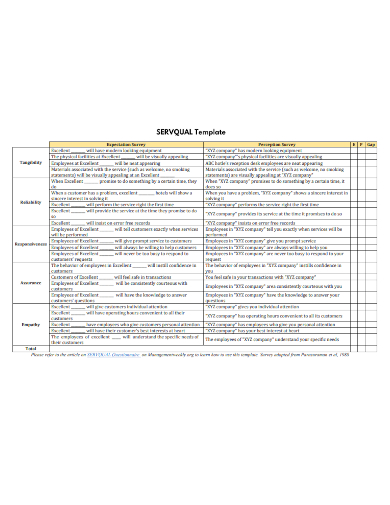
managementweekly.org
Service Provider Questionnaire

hr.upenn.edu
Customer Satisfaction Survey Questionnaire

marlobeauty.com
Employee Experience Survey Questionnaire
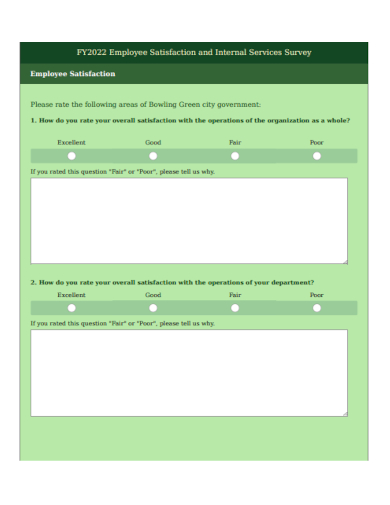
bgky.org
Benefits of Conducting Service Questionnaire:
Conducting service questionnaires can yield numerous benefits for a business or service provider:
- Enhanced Customer Insight: They provide valuable data about customer preferences, expectations, and experiences, enabling companies to understand their client questionnaire better.
- Improved Service Quality: By identifying what customers value and where they see room for improvement, businesses can refine their services to better meet customer needs.
- Increased Customer Engagement: Asking for feedback questionnaire shows customers that their opinions are valued, which can increase their engagement with the brand.
- Informed Decision Making: The insights gained from service questionnaires can guide strategic decisions, from service delivery to product development.
- Performance Tracking: Regularly issued questionnaires can help track changes in customer satisfaction over time, revealing the impact of new initiatives or market changes.
- Competitive Advantage: Understanding customers better than competitors do can provide a significant advantage in tailoring services and capturing market share.
- Operational Efficiency: Feedback can highlight operational problems or inefficiencies that, once addressed, can streamline service delivery and reduce costs.
- Risk Management: By revealing areas of dissatisfaction, service questionnaires can help companies address issues before they escalate into larger problems or damage the brand.
- Personalized Services: Data from questionnaires can enable companies to offer more personalized services, enhancing customer satisfaction and loyalty.
- Positive Word-of-Mouth: Satisfied customers identified through questionnaires can become brand ambassadors, spreading positive word-of-mouth and referrals.
- Regulatory Compliance: Feedback can help ensure that services meet industry standards and regulatory requirements, avoiding fines and legal issues.
- Benchmarking: Service questionnaires can be used to benchmark against industry best practices, helping businesses understand where they stand relative to competitors.
Tips on Making a Good Service Questionnaire:
Now that you know how to make a questionnaire, every once in a while these questionnaires should be improved too. These type of questionnaire are unlike health questionnaires, which is more standard than other survey questionnaires. Here are tips in making a better service questionnaire:
- Make It Short. Service questionnaires must not be too long because this would require so much time for the customers to answer.
- Direct to the Point. Service questionnaires are not test questionnaires that has to be complex. Remember that this is for the general public, so make it direct and use simple terms that can easily be understood.
- Use Close-Ended Questions. It is much more easier to analyze when answers are close-ended rather than open-ended. It can also be open-ended but questions that requires this kind of answer would for suggestions.
- Visual Presentation. It also makes a difference when you put a little bit more effort in making those questionnaires. Take time to put design. Through this, customers would have the impression that the service questionnaires made are not only for show but are really taken seriously by the management. With that, you make customers feel that what they think are meaningful.
Why are customer satisfaction surveys important?
Customer satisfaction surveys are important for several reasons:
- Feedback on Performance: They provide direct feedback from customers regarding what a company is doing well and where it needs to improve.
- Customer Retention: Satisfied customers are more likely to remain loyal, and surveys can identify the factors that contribute to satisfaction.
- Identify Problems: Surveys can uncover specific problems that customers are experiencing, allowing businesses to address them proactively.
- Decision-Making Data: The data from these surveys can inform business decisions, helping to prioritize areas for investment or improvement.
- Benchmarking: They allow businesses to benchmark their performance against industry standards or competitors.
- Product and Service Development: Customer feedback can guide the development of new products or the refinement of existing services.
- Customer Engagement: By soliciting opinions, companies can engage with their customers, making them feel heard and valued.
- Marketing Insights: Understanding customer satisfaction can help in tailoring marketing strategies to target happy customers for referrals or dissatisfied ones with retention efforts.
- Employee Performance: They can also provide insights into employee performance from the customer’s perspective, which can be useful for training and development.
- Legal and Compliance: Feedback can help ensure that a company’s offerings meet regulatory requirements and industry standards, reducing legal risks.
11+ Service Questionnaire Examples to Download

For a service provider business, it is their main objective to provide outstanding customer service. It is a service providers smart goal or target to make their customers satisfied and happy. At first, there would always be shortcomings when providing services and a those flaws would really need to be improved.
There are many ways to improve a business’s service questionnaire. One way would be to use questionnaire examples that states how satisfied a customer is to the service they have received. Feedback is one significant requirement in the process of improving the quality of the service. What is this type of questionnaire?
Customer Service Questionnaire

who.int
Details
File Format
PDF
Size: 26 KB
Quality Service Questionnaire
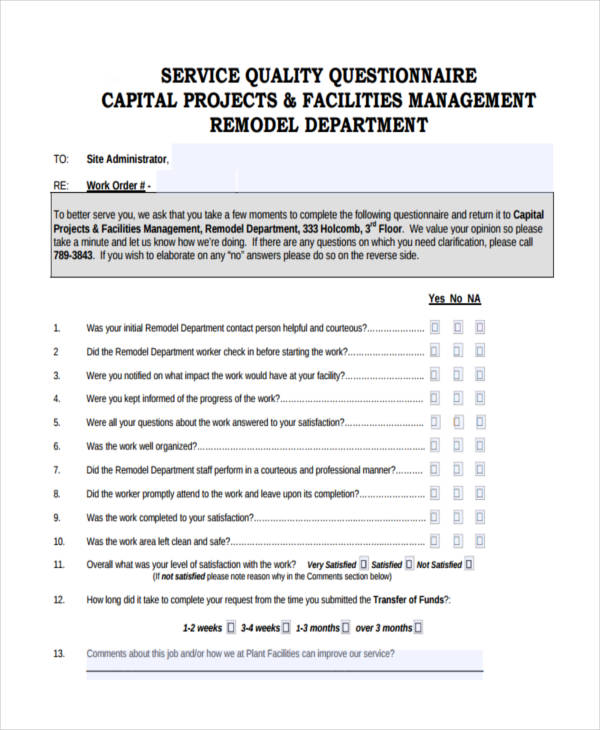
washoecountyschools.net
Details
File Format
PDF
Size: 39 KB
Service Feedback Questionnaire
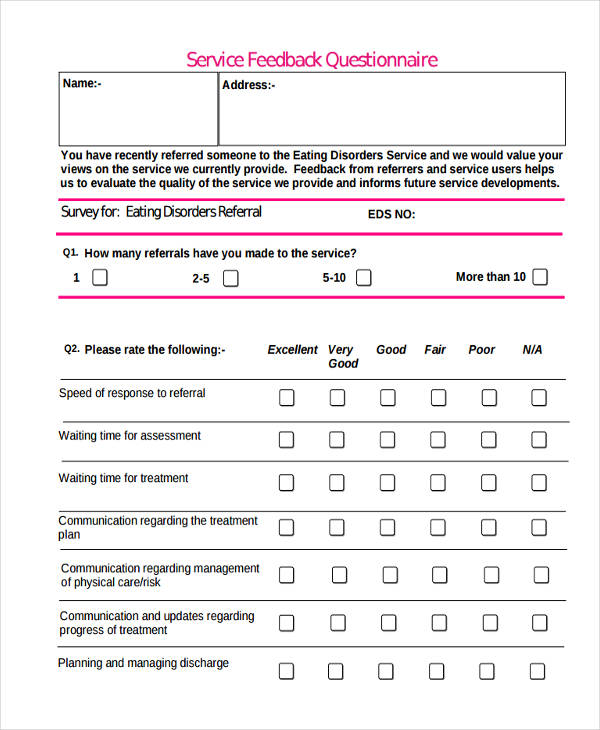
southernhealth.nhs.uk
Details
File Format
PDF
Size: 113 KB
Service Delivery Questionnaire
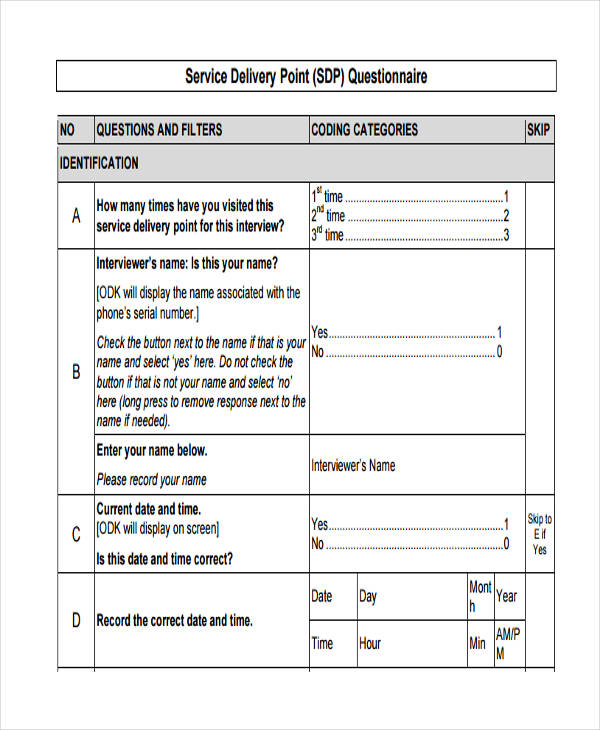
pma2020.org
Details
File Format
PDF
Size: 314 KB
What is Service Quality Questionnaire?
A service questionnaire is a tool used by businesses and organizations to gather feedback from customers or clients about the quality and effectiveness of the services they have received. It typically consists of a series of questions that aim to assess customer satisfaction, identify areas for improvement, understand the needs and expectations of customers, and measure service performance against certain benchmarks or standards.
Service questionnaires can take various forms, such as online surveys, paper forms, telephone interviews, or even face-to-face interactions in certain cases. They might include:
Introduction:
Purpose of the Questionnaire: Explaining why the feedback is important.
Instructions: Guiding respondents on how to fill out the questionnaire.
Privacy Statement: Assuring respondents that their feedback is confidential.
Service Quality Assessment:
Timeliness: Questions about the promptness of the service provided.
Reliability: Whether the service was dependable and consistent.
Professionalism: Queries about the conduct of the service providers.
Efficiency: How effectively the service was delivered.
Customer Satisfaction:
Overall Satisfaction: A general question about the customer’s level of satisfaction survey with the service.
Expectation vs. Reality: Determining if the service met, exceeded, or fell short of expectations.
Likelihood of Repeat Use: Gauging if the customer would use the service again.
Likelihood of Recommendation: Assessing if the customer would recommend the service to others.
Specific Service Attributes:
Accessibility: Ease of accessing the service.
Communication: Effectiveness of communication with service providers.
Problem Resolution: Ability and speed in resolving any issues.
Value: Customer’s perception of the service’s value for the money spent.
Open-Ended Feedback:
Comments and Suggestions: Space for detailed feedback, suggestions for improvement, or other comments.
Experiences: Request for any noteworthy positive or negative service experiences.
Customer Information (optional):
Demographics: Information such as age, gender, location for more detailed analysis.
Service Usage Patterns: How often the customer uses the service, preferences, etc.
Closing Remarks:
Thank You Note: Expressing appreciation for the customer’s time and feedback.
Contact Information: Offering a way for the customer to reach out if they have further input.
When designing a service questionnaire, it’s important to keep questions clear, concise, and relevant to the objectives of the feedback collection. The questionnaire should not be overly long to avoid respondent fatigue, and it should be formatted in a way that makes it easy to complete.
What is the purpose of a Service Questionnaire?
A service questionnaire is designed to:
Gather Customer Feedback: It collects detailed information about customers’ experiences with a company’s service, including satisfaction and areas for improvement.
Measure Service Quality: A questionnaire allows a business to evaluate how well it is delivering on service promises and customer expectations.
Identify Service Gaps: By analyzing responses, a company can identify gaps in service delivery and opportunities for enhancement.
Enhance Customer Experience: Insights gained can be used to tailor services to better meet customer needs, thus improving the overall customer experience.
Drive Business Decisions: The data collected can inform business decisions, influencing everything from day-to-day operations to long-term strategic planning.
Benchmark Performance: Organizations can use questionnaires to benchmark their service quality against industry standards or competitor practices.
Track Improvements Over Time: Repeated surveys can help a business track its performance over time and measure the effectiveness of any changes made.
Foster Customer Relationships: By soliciting feedback, a company demonstrates that it values its customers’ opinions, which can strengthen customer relationships.
Comply With Regulatory Standards: Certain industries may use service questionnaires to ensure they meet customer service requirements set by regulatory bodies.
Enable Personalization: Responses can be used to personalize services to individual customer preferences, thereby enhancing satisfaction and loyalty.
Getting to Know Service Questionnaire
As mentioned earlier, one way to improve quality of a service is through a questionnaire.
This type of questionnaire is called a service questionnaire, which contains questions related to the services that a business renders to a customer, aiming to achieve feedback that can help business improve the quality evaluation of their services.
A customer service questionnaire can tackle about how customers are satisfied with the services provided to them as well as how it did not satisfy them, which we hope not, and what they would like to suggest for improving service quality.
How to Create a Service Questionnaire?
Now that we know what a service satisfaction questionnaire is, we would also have the idea on how to create one. Service questionnaires don’t have any standards, format or whatsoever. What matters are the questions and the desired answers.
To make the questionnaire, businesses have to formulate questions that asks about the service they are providing. It must never be for another business but for their own business. Questions must be based from observations in the service of the business and questions like how much they rate their level of satisfaction should also be included.
Sample Service Questionnaire
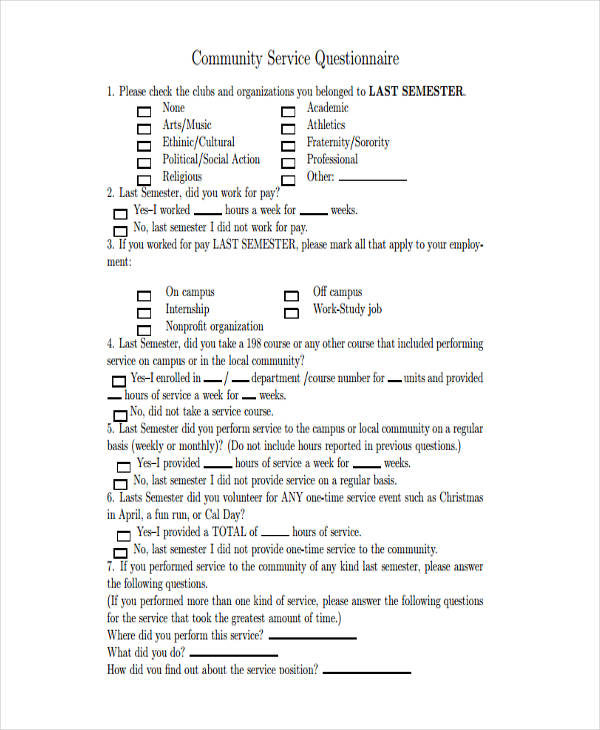
stat.berkeley.edu
Details
File Format
PDF
Size: 22 KB
Service Evaluation Questionnaire
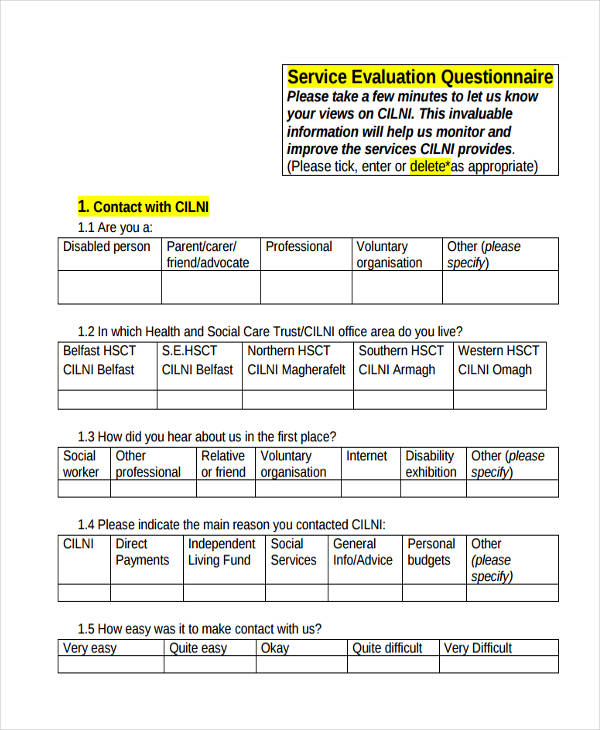
cilbelfast.org
Details
File Format
PDF
Size: 129 KB
Quality Food Service Questionnaire
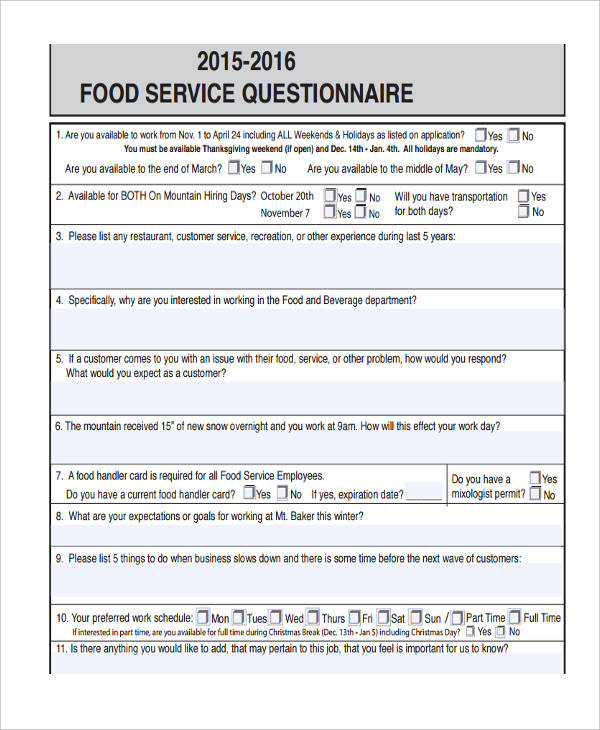
jobs.mtbaker.us
Details
File Format
PDF
Size: 105 KB
Medical Service Questionnaire
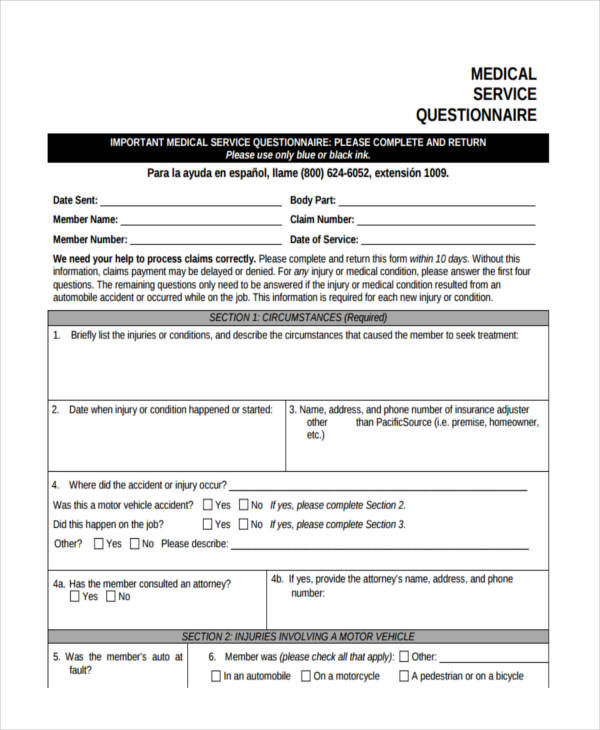
pacificsource.com
Details
File Format
PDF
Size: 37 KB
Servqual Questionnaire Sample

managementweekly.org
Details
File Format
PDF
Size: 100 KB
Service Provider Questionnaire

hr.upenn.edu
Details
File Format
PDF
Size: 738 KB
Customer Satisfaction Survey Questionnaire

marlobeauty.com
Details
File Format
PDF
Size: 8 KB
Employee Experience Survey Questionnaire

bgky.org
Details
File Format
PDF
Size: 195 KB
Benefits of Conducting Service Questionnaire:
Conducting service questionnaires can yield numerous benefits for a business or service provider:
Enhanced Customer Insight: They provide valuable data about customer preferences, expectations, and experiences, enabling companies to understand their client questionnaire better.
Improved Service Quality: By identifying what customers value and where they see room for improvement, businesses can refine their services to better meet customer needs.
Increased Customer Engagement: Asking for feedback questionnaire shows customers that their opinions are valued, which can increase their engagement with the brand.
Informed Decision Making: The insights gained from service questionnaires can guide strategic decisions, from service delivery to product development.
Performance Tracking: Regularly issued questionnaires can help track changes in customer satisfaction over time, revealing the impact of new initiatives or market changes.
Competitive Advantage: Understanding customers better than competitors do can provide a significant advantage in tailoring services and capturing market share.
Operational Efficiency: Feedback can highlight operational problems or inefficiencies that, once addressed, can streamline service delivery and reduce costs.
Risk Management: By revealing areas of dissatisfaction, service questionnaires can help companies address issues before they escalate into larger problems or damage the brand.
Personalized Services: Data from questionnaires can enable companies to offer more personalized services, enhancing customer satisfaction and loyalty.
Positive Word-of-Mouth: Satisfied customers identified through questionnaires can become brand ambassadors, spreading positive word-of-mouth and referrals.
Regulatory Compliance: Feedback can help ensure that services meet industry standards and regulatory requirements, avoiding fines and legal issues.
Benchmarking: Service questionnaires can be used to benchmark against industry best practices, helping businesses understand where they stand relative to competitors.
Tips on Making a Good Service Questionnaire:
Now that you know how to make a questionnaire, every once in a while these questionnaires should be improved too. These type of questionnaire are unlike health questionnaires, which is more standard than other survey questionnaires. Here are tips in making a better service questionnaire:
Make It Short. Service questionnaires must not be too long because this would require so much time for the customers to answer.
Direct to the Point. Service questionnaires are not test questionnaires that has to be complex. Remember that this is for the general public, so make it direct and use simple terms that can easily be understood.
Use Close-Ended Questions. It is much more easier to analyze when answers are close-ended rather than open-ended. It can also be open-ended but questions that requires this kind of answer would for suggestions.
Visual Presentation. It also makes a difference when you put a little bit more effort in making those questionnaires. Take time to put design. Through this, customers would have the impression that the service questionnaires made are not only for show but are really taken seriously by the management. With that, you make customers feel that what they think are meaningful.
Why are customer satisfaction surveys important?
Customer satisfaction surveys are important for several reasons:
Feedback on Performance: They provide direct feedback from customers regarding what a company is doing well and where it needs to improve.
Customer Retention: Satisfied customers are more likely to remain loyal, and surveys can identify the factors that contribute to satisfaction.
Identify Problems: Surveys can uncover specific problems that customers are experiencing, allowing businesses to address them proactively.
Decision-Making Data: The data from these surveys can inform business decisions, helping to prioritize areas for investment or improvement.
Benchmarking: They allow businesses to benchmark their performance against industry standards or competitors.
Product and Service Development: Customer feedback can guide the development of new products or the refinement of existing services.
Customer Engagement: By soliciting opinions, companies can engage with their customers, making them feel heard and valued.
Marketing Insights: Understanding customer satisfaction can help in tailoring marketing strategies to target happy customers for referrals or dissatisfied ones with retention efforts.
Employee Performance: They can also provide insights into employee performance from the customer’s perspective, which can be useful for training and development.
Legal and Compliance: Feedback can help ensure that a company’s offerings meet regulatory requirements and industry standards, reducing legal risks.

